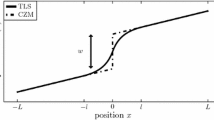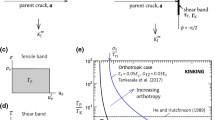Abstract
The failure of quasi-brittle specimen weakened by sharp or blunted notches and cavities is analyzed under quasi-static loading. The load at failure is obtained with the Thick Level Set (TLS) damage modeling. In this model, the damage gradient is bounded implying that the minimal distance between a point where damage 0 (sound material) to 1 (fully damaged) is an imposed characteristic length in the model. This length plays an important role on the damage evolution and on the failure load. The paper shows that the TLS predictions are relevant. A comparison with the coupled criterion (CC) of Leguillon (2002) is given. A good agreement is obtained for cavities and V-notches provided that the characteristic length of Irwin is small compared to the notch depth (condition for the applicability of the CC criterion). A comparison with failure loads obtained experimentally is also given. In the numerical simulations, uniform stresses are imposed at infinity using a new finite element mapping technique (Cloirec 2005).





















Similar content being viewed by others
Notes
Sample sizes used for experiment are large enough to consider that notches are in semi-infinite media.
References
Bazant ZP, Belytschko TB, Chang TP (1984) Continuum theory for strain-softening. J Eng Mech ASCE 110(12):1666–1692
Bernard P-E, Moës N, Chevaugeon N (2012) Damage growth modeling using the Thick Level Set (TLS) approach: efficient discretization for quasi-static loadings. Comput Methods Appl Mech Eng 233–236:11–27
Carpinteri A, Cornetti P, Pugno N, Sapora A, Taylor D (2008) A finite fracture mechanics approach to structures with sharp V-notches. Eng Fract Mech 75(7):1736–1752
Cloirec M (2005) Application of X-FEM for multi-scale problems and parallel computations. Theses, Ecole Centrale de Nantes (ECN); Université de Nantes
Dunn ML, Suwito W, Cunningham S, May CW (1997) Fracture initiation at sharp notches under mode I, mode II, and mild mixed mode loading. Int J Fract 84(4):367–381
Frémond M, Stolz C (2017) On alternative approaches for graded damage modelling. In: Frémond M, Maceri F, Vairo G (eds) Models, simulation and experimental issues in structural mechanics, vol 8. Solids and structural mechanics. Springer, Cham, pp 87–104
Gómez AP (2015) Coupled numerical and analytical analysis of a graduated damage model. Theses, Ecole Centrale de Nantes (ECN)/Université Nantes Angers Le Mans
Gómez FJ, Elices M (2003) A fracture criterion for sharp V-notched samples. Int J Fract 123(3):163–175
Gómez FJ, Elices M (2004) A fracture criterion for blunted V-notched samples. Int J Fract 127(3):239–264
Gómez A-P, Moës N, Stolz C (2015) Comparison between thick level set (TLS) and cohesive zone models. Adv Model Simul Eng Sci 2(18):1–22
Irwin GR (1968) Linear fracture mechanics, fracture transition, and fracture control. Eng Fract Mech 1(2):241–257
Leguillon D (2002) Strength or toughness? A criterion for crack onset at a notch. Eur J Mech A Solids 21(1):61–72
Lions P-L (1982) Generalized solutions of Hamilton–Jacobi equations. Pitman Advanced Publishing Program, Boston
Leguillon D, Quesada D, Putot C, Martin E (2007) Prediction of crack initiation at blunt notches and cavities? Size effects. Eng Fract Mech 74:2420–2436
Leguillon D, Yosibash Z (2003) Crack onset at a v-notch. Influence of the notch tip radius. Int J Fract 122(1/2):1–21
Li J, Zhang XB (2006) A criterion study for non-singular stress concentrations in brittle or quasi-brittle materials. Eng Fract Mech 73(4):505–523
Moreau K, Moës N, Chevaugeon N, Salzman A (2017) Concurrent development of local and non-local damage with the thick level set approach: implementation aspects and application to quasi-brittle failure. Comput Methods Appl Mech Eng 327:306–326
Moës N, Stolz C, Bernard P-E, Chevaugeon N (2011) A level set based model for damage growth: the thick level set approach. Int J Numer Methods Eng 86:358–380
Moës N, Stolz C, Chevaugeon N (2014) Coupling local and non-local damage evolution with the Thick Level Set model. Adv Model Simul Eng Sci 2(16):21
Picard D, Leguillon D, Putot C (2006) A method to estimate the influence of the notch-root radius on the fracture toughness measurement of ceramics. J Eur Ceram Soc 26(8):1421–1427
Sethian JA (1999) Level set methods and fast marching methods: evolving interfaces in computational geometry, fluid mechanics, computer vision and material science. Cambridge University Press, Cambridge
Stolz C (2016) On moving thick layer approach for graded damage modelling. Int J Fract 202(2):195–205
Tada H, Paris PC, Irwin GR (2000) The stress analysis of cracks handbook, 3rd edn. ASME Press, New York
Williams ML (1952) Stress singularities resulting from various boundary conditions in angular corners of plates in extension. J Appl Mech Trans ASME 19:526–528
Acknowledgements
N.M., K.M., C.S. and J.Z. gratefully acknowledges the support of the ERC advanced Grant XLS no. 291102.
Author information
Authors and Affiliations
Corresponding author
Additional information
Publisher's Note
Springer Nature remains neutral with regard to jurisdictional claims in published maps and institutional affiliations.
Appendices
Appendix A: Details on the softening function and damage profile used in the TLS numerical simulations
The TLS model considered is given by:
where \(\lambda _\mathrm {c}\) is a dimensionless parameter defined as the ratio between the TLS thickness (\(2 l_\mathrm {c}\)) and the cohesive zone length:
The above choice (61) corresponds to a linear cohesive relation [already considered in Gómez et al. (2015)]. Indeed, inserting g(d) into (27), we get:
Eliminating d in the above yields:
The toughness is given by:
The following data for PMMA are used:
This implies:
Regarding the choice for \(\lambda _\mathrm {c}\), it needs to be less or equal to 0.5 (Gómez et al. 2015) otherwise the convexity requirement of \(\tilde{h}\) is not satisfied. We consider:
leading to
Note that for a more general cohesive law
the function \(\tilde{h}(d, \lambda _\mathrm {c})\) is obtained as the solution to the equation
Conditions (7) imply some restrictions on the choice of \(f_\mathrm {coh}\) and \(\lambda _\mathrm {c}\).
Appendix B: Generalized stress intensity factor for an edge notch in an infinite medium
The generalized stress intensity factor k at the tip of a notch with depth a in an infinite medium subjected to a prescribed tension \(\sigma _\infty \) is given by:
where the parameter \(\kappa \) is given in Table 2 one has to keep in mind the normalization proposed in Sect. 2.1. For the crack (\(\omega =0\)) with the usual normalization of the mode I eigenvector, it gives \(\kappa ^\prime =1.119\) to be compared to the coefficient 1.122 proposed by Tada et al. (2000).
Appendix C: Data for the coupled criterion—cases of sharp and blunted V-notch
The scalar \(\lambda \) is the root of the equation:
whereas values of \(A^{\star }\) derive from an asymptotic procedure carried out with respect to the small crack extension length \(l_{\mathrm {CC}}\) (Leguillon 2002). The values found in this reference are made dimensionless multiplying by \(E/(1-\nu ^2)\). Moreover, keep in mind again the normalization of the eigenvector in Sect. 4.1 (Fig. 22).
Similarly \(B^{\star }\) and \(C^{\star }\) derive from an asymptotic procedure but carried out with respect to the notch root radius \(\rho \). The \(B^{\star }\) and \(C^{\star }\) coefficients were computed for a Young modulus \(E= 2300~\mathrm{MPa}\) and a Poisson ratio \(\nu =0.3\) and then multiplied by \(E/(1-\nu ^2)\). As \(A^{\star }\), they are functions of \(\omega \) and in addition they depend also on the dimensionless crack length \(\zeta =l_{\mathrm {CC}}/\rho \) which plays the role of a parameter in the model involving both lengths \(\rho \) and \(l_{\mathrm {CC}}\). It is illustrated in Figs. 23 and 24. Attention is drawn to the fact that \(C^{\star }\) only slightly deviates from 1 except for small values of \(\zeta \). This later case corresponds to large root radii compared to the crack length at initiation. At the limit it falls outside the scope of the asymptotic expansion used here which assumes that the two small parameters \(\rho \) and \(l_{\mathrm {CC}}\) are of the same order of magnitude. A different procedure has to be employed (Tables 3, 4, 5, 6, 7).
Appendix D: Data for the coupled criterion—cavity
Rights and permissions
About this article
Cite this article
Zghal, J., Moreau, K., Moës, N. et al. Analysis of the failure at notches and cavities in quasi-brittle media using the Thick Level Set damage model and comparison with the coupled criterion. Int J Fract 211, 253–280 (2018). https://doi.org/10.1007/s10704-018-0287-6
Received:
Accepted:
Published:
Issue Date:
DOI: https://doi.org/10.1007/s10704-018-0287-6









